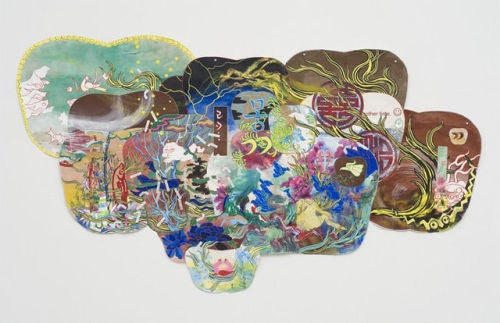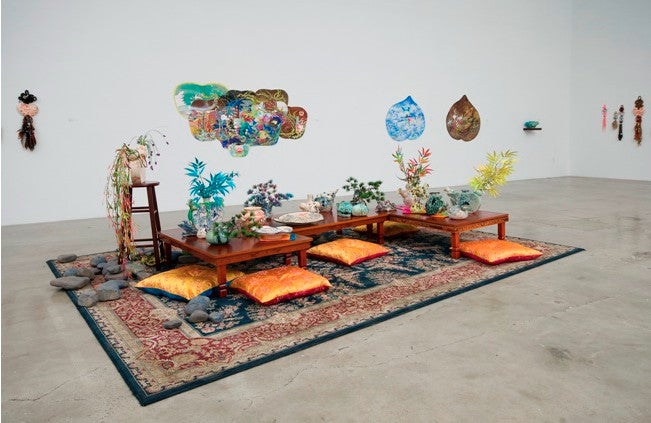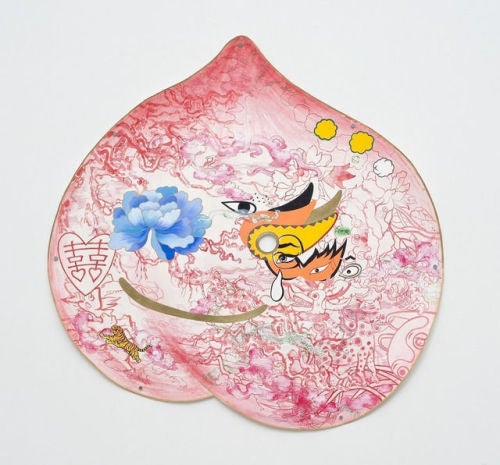
In a New Yorker review, critic Peter Schjeldahl once admonished Jeff Koons for depicting a Play-Doh sculpture in a series of photorealist paintings: “Painting is a medium of concerted imagination, symbolizing consciousness. It’s not a flat dump for miscellaneous ideas.” Jiha Moon’s recent exhibition at the Museum of Contemporary Art of Georgia (MOCA GA), entitled Foreign Love nevertheless flirts with the notion. Flattening does the show’s heavy lifting. Painted works on paper retain a sense of completion and independence. When they work best, Moon’s lavish installations operate independently. But, when viewed in the context of her stronger painted works, their concrete presence, symbolically complete, seems to be at odds with a matrix of intervening mark-making that is inscribed on their surfaces.
The exhibition officially consists of three categories of mediums: works on paper, ceramic sculptures, and norigae, a Korean tassel form that functions both as a fashion accessory and talisman (perhaps the two aren’t separate). In themselves norigae represent a fascinating phenomenon, and the objects that Moon presents are complicated and suffused with the paradoxes inherent to consumer culture. Eighteen objects in all constitute the array. They hang separately from one another, each combining braided doll hair and ceramic heart forms glazed with Moon’s usual repertoire of cross-cultural signifiers. The use of doll hair is unusually provocative and cross-pollinates with drawings inscribed onto the ceramic medallions in confusing ways. It seems unnecessarily oblique for the artist to make visual comparisons between the imagery in the paper works and the norigae. Imported into the museum, these artifacts also make ambiguous demands on the viewer. Are they meant to be exposed to the white box environment, which is ideologically charged with Western values and histories, or should they be viewed under the protective glass of a vitrine, which insulates some of the context of the original lived history and context?

Domestic-looking sculptural tableaus dominate the eye-line of the main gallery. The installations offer even more fodder for contemplation, but erode some of the show’s consistency. Small shelves house ceramic vessels sometimes sprouting shoots. A large tableau replete with a squat dining table is marked off with a rug and quarantined with tape to prevent tampering. Head-shaped vases that mimic forms in the paintings support a selection of shoots and evergreen branches. Close inspection reveals that the artist has replaced some of the vegetation with handwoven objects. The vertical variety of plant forms and the weight of the ceramic pin the table into place. The whole apparatus communicates entrapment, and maybe not in a negative way. Referentially, the over-fertile affair has a shorter reach than the two-dimensional works that make reference to an imaginary world. The installation orients itself exactly where it sits; it is oriented closer to home and tempers the hypothetical wandering of the paintings.
Overlapping styles and motifs move in weather patterns through Moon’s paintings. Images aren’t wrestled into place, nor are they depicted as symbolically wrought from an uncooperative raw material. Moon ushers ideas like butterflies into the airy enclosure of her artistic vision with the slow-arcing casualness of an entomologist. That’s not to say that the work is staid. Surfaces teem with signs, pop cultural and otherwise, trafficked through a carefully modulated pictorial ambiance that holds them in temporary suspension. Angry birds, Roy Lichtensteinian brush strokes, and R2-D2 float inside an organizational form that looks like a fruit.

Peach Mask I, II, and III (2013) are painted with ink and acrylic on Hanji, a Korean paper derived from a mulberry tree. All three works are fixed directly onto the wall and riff off of the multiple-headed figure present in Yellow Wave (2012–2013), the most ambitious painting of the set. The exhibition’s namesake painting, Foreign Love (2013), brings into focus a face motif that is asserted and suppressed in the other work. A snarling face peaks through the ripped picture plane stained with an Asian landscape. In interviews, the artist describes a penchant for misleading viewers with regard to the ethnic origins of images, but the critical component of understanding the paintings seems to be the organizational psychology of the head, which mediates the maelstrom. The heads of Peach Mask I, II, and III offer the perfect cypher for the clotted vocabulary contained within them. Their disembodied, rounded forms and helplessly blinking features bring to mind kawaii, a cultural phenomenon derived from Japan. Kawaii subjects, real and fictional, embody cuteness, an idea and aesthetic category that serves as a binder for the feeling of alienation in highly contemporary and heavily networked societies. As subjects, the peaches don’t need to make sense of internal turmoil, and as a device dealing with identity, they pad the severity of judgment a viewer might be inclined to feel toward a more capable and closer-to-human subject. Presumably, the interior noise of Moon’s figures taps into the similarities of diverse alphabets not to make a structural argument or to demonstrate her aptitude for bending signification as a cultural transplant herself, but to picture a sense of psychological dislocation that is universal.




